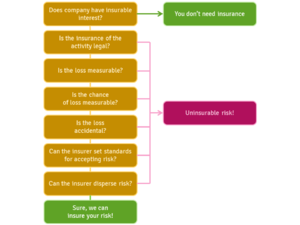Uninsurable risk
| Uninsurable risk |
|---|
| See also |
Uninsurable risk is a situation that is related to unknowable or unacceptable risk or is against the law. Such a risk can be very dangerous for insurance company, thus those companies try to avoid insuring uninsurable risk.
When uninsurable risk is related to an investment that is important for society or country, the government can give guarantees that are kind of insurance. That helps to make some large investments.
Law can forbid some types of insurance, e.g. for criminal penalties. Other uninsurable risks are:
- risk to reputation
- regulatory risk
- trade secret risk
- political risk
- pandemic risk
Risk to reputation
Reputation risk - is a threat to the organization. It can occur in everyday operations related to the project and difficulties in the company's development plans. Loss of reputation affects competitiveness, weakness the company's dynamism and reduces the value of developing investments.Reputational risk applies not only to individual organizations but it can affect the entire industry. Reputation risk is a threat to the good name or position of the company. Reputation risk may occur as a result of the actions of the company itself, employees or other entities related to the company. Companies need to be responsible and consciously managed to avoid or minimize the risk of losing reputation [1].
Regulatory risk
Regulatory risk - is the risk of losses resulting from changes in laws and regulations. Organizations must stabilize investment prices to reduce anti-competitive behavior. The change of regulations may affect the market, sector and security. Regulatory risk may first and foremost appear in the offer of services and products in which companies may get involved. It may result from events such as a change in rates that may encumber or that may hinder business operations. New laws and regulations can greatly impact the value of shares of the company. The company which is facing high compliance costs may see its stock price fall [2].
Trade secret risk
Trade risk - is the risk related to buyers, the financial situation on the market, payment habits and honesty in fulfilling the obligations arising from the sales contract.Exporters and importers engage in trade and are exposed to significant risks. For the purpose of mitigation, contractors can offer import and export guarantees with an additional fee. The market and competition forces companies to offer more and more favorable terms of cooperation and to extend payment deadlines, which results in an increase in commercial risk and delays in payment and delivery or in its absence [3].
Political risk
Political risk - is a risk when return on investment may suffer as a result of political changes or instability in the country. This may be due to changes in the government, political system and legislative bodies. The state is a source of sudden and unexpected changes in financial flows and may affect the market value of implemented investments. Before making the investment, the company should conduct research on the country's risk. This will help to estimate in which countries there is a high political risk not to trigger unnecessary operations in these countries [4].
Pandemic risk
Pandemic risk - is a rapidly spreading infectious disease that can be a global threat. Pandemics can create social and economic chaos. They disrupt business operations, supply operations, resulting in a shortage of employees. This makes it difficult to provide products and services to customers.The disease is a high risk of morbidity and mortality.Risk management involves the use of emergency plans in society in order to mitigate the impact on health and the economy. Governments should deal with the estimation of public obligations to manage conditional obligations.It is important to determine how the company intends to react to the situation and define the rules for the management of personnel and communication [5].
References
- Jaffee, D. M., & Russell, T. (1997). Catastrophe insurance, capital markets, and uninsurable risks. Journal of Risk and Insurance, 205-230.
- Jonas, O. B. (2013). Pandemic risk. The World Bank
- Larse, E. R., & Bunn D. W. (1999). Deregulation in the electricity sector: understanding strategic and regulatory risk. Journal of the Operational research Society
- Niepmann, F., & Schmidt-Eisenlohr T. (2014). International trade, risk and the role of banks. Cesifo Working Paper, No. 4761
- O'Callaghan, T. (2007). Disciplining multinational enterprises: the regulatory power of reputation risk. Global Society, Vol. 21
- Tabellini, A. A. G. (1989). External debt, capital flight and political risk. Journal of International Economics
Footnotes
Author: Weronika Góra
